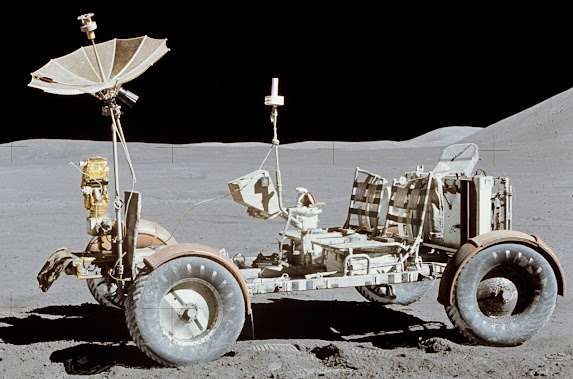During the 1971/ 72 moon landing missions, the crew had rovers, electric buggies to get around and enable collection of samples. This mobile platform underpinned testing missions over a much greater distance than than humans could have walked, or bounced. With over half a century of development since then, there has been some speculation about ground transport across the regolith of Mars. Let's discuss what has gone before and what is down the road for off-world ground transportation.
The journey of 4-wheeled off-world vehicles started with the Moon Lander buggy, or Lunar Roving Vehicle (LRV), as its formal designation. For the time, they were advanced technology, built by long term NASA commercial partner, Boeing.
The kerb weight stats highlight clearly the impact of low gravity on the moon. At 460 lb on Earth (210 kg), it only weighed 76 lb (34 kg) on the moon. This suggests that an astronaut could pick the whole un-laden vehicle with two hands. Just a bit heavier than a bag of sand.
What's more impressive is that the whole vehicle was flat-packed, then assembled on the moon, unlike the Tesla Roadster which Elon Musk shot - fully constructed - into orbit atop the Falcon Heavy launch system, that car itself now follows an elliptical orbit around the solar system.
Star-man in the SpaceX flight suit, chilling in space, travelling in orbit of the whole solar system at thousands of kilometres an hour. Credit: SpaceX/ WikipediaThe video below clearly explains the long journey of Starman after he completed a flyby of Mars over a year ago.
New Model
Many Tesla fans have anticipated the deployment of a cyber truck on Mars: particularly because of the excellent air filter technology, power reserve, hauling ability, off-road ability and large cab and flatbed.
These properties serve well on Mars, especially due to the fact that the crew will be doing plenty of heavy habitat construction, hauling materials, equipment and experiments to different parts of the surface.
Stats for the cyber truck are impressive - having superior torque to any production truck out there, with the long-range battery capacity to match. This contrasts sharply with the LRVs of the Apollo missions, 3 of which were brought to the Lunar surface in 1971 and 1972, having only 92 km of range in their silver oxide batteries.
The Cybertruck in contrast, will carry a payload of batteries offering 500 + miles of range (estimated). This will give plenty of range for extended missions to visit sites identified near the human landing zones. Right now the front runner of which is purported to be...
The second benefit in the short term is gathering of samples from different parts of the surface. The cyber truck has a 6.5 ft flatbed - great for loading and unloading good spans of bulky goods/ equipment.
What is even more impressive is the tri-motor configuration with 14,000 lb of towing capacity. This offers not only heavy hauling (which will increase 60% due to approx 40% of Earth gravity on Mars. --> bringing towing closer to 23,000lb). As a result, this offers a tantalising mobile habitat opportunity - if they can get the habitat access/ egress airlocks right to prevent contamination with toxic perchlorate dust as discussed earlier.
This will be a key mission for the in situ resource utilisation work stream, as habitats, food, water, air will be produced in the short term. Longer term, as discussed briefly in an earlier post, the colonists will work on producing more durable materials, advanced habitat materials, and - if this patent from Tesla is to be followed, more machine that makes the machine style constructions.
Remember - on top of all this ground transportation - the lower gravity on Mars offers the chance at very long range helicopter missions. The Ingenuity helicopter drone prototype offers the first steps in this endeavour. Such equipment will enable humans to cover more ground more quickly.
You can reach me on Twitter: @Ronnie_Writes




Comments
Post a Comment